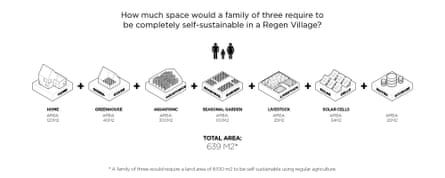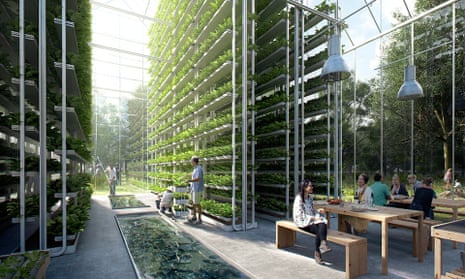When a massive wildfire destroyed more than a thousand homes last year in the bone-dry hills of drought-stricken Lake County, California, about two hours north of San Francisco, Magdalena Valderrama Hurwitz and her husband, Eliot Hurwitz, were among those made homeless. Eager to transform their tragedy into an opportunity, they got together with a group of neighbors who had also lost their homes and began imagining a different kind of community.
Valderrama Hurwitz, a former non-profit administrator, and her husband, a retired strategic planner with the Napa County Transportation and Planning Agency, didn’t want to replace their house with an oversized energy guzzler, isolated from their neighbors. Instead, they began exploring ways to create a so-called intentional community: a neighborhood that could better protect them from climate change-related risks and be a model for how to live with less impact on the planet.
“We want to try to mitigate and prepare for future disasters, and for us that resiliency should include a new way to develop rather than the kind of suburban, single-family home with people isolated from each other living in their own castles,” Valderrama Hurwitz says.
More than 5,000 miles away, in Amsterdam, a California-based development company called ReGen Villages is about to break ground on a very similar project. When it’s completed next year, an off-grid development of 100 homes will aim to be almost completely self-sufficient. Each 25-home cluster will encircle several food production facilities for growing organic produce and raising chicken and fish using advanced agricultural technologies that require less land, like aquaponics and vertical farms. The settlement will generate its own wind, solar and biogas power and manage its wastewater in a closed-loop system that also captures waste to be recycled as energy and fertilizers.
James Ehrlich, CEO and founder of ReGen Villages, says the company decided to launch in northern Europe because the region has a solid track record designing housing that reduces ecological impact. ReGen – an abbreviation of regenerative – has plans to replicate its pilot project at sites in Sweden, Norway, Germany and Denmark in the next couple of years to further study the model before expanding globally.
“The EU has taken the lead in many ways on rethinking residential development in ways that support lowering carbon footprints,” Ehrlich says.
Valderrama and Hurwitz wondered if the ReGen Villages project in the leafy, eco-conscious Netherlands could be adapted to their drought-prone, rural California county. They are among a growing number of US-based landowners, developers and local governments interested in bringing variations of the template to their own communities who have contacted Ehrlich since ReGen Villages was unveiled at the Venice Biennale in May.

But the US is not northern Europe. Replicating the European ReGen Villages model in a country with one of the largest ecological footprints for housing requires changing a political culture that’s more conservative and more skeptical about investing in sustainability. It also means rethinking zoning and financing systems that favor conventional single-family developments.
Nonetheless, Ehrlich sees opportunities to have several US-based projects in the pipeline during the next five years. ReGen Villages will choose its first American development sites strategically, he says. The company will prioritize communities where local government is already open to bold approaches to residential sustainability and where they might partner with local universities and other research institutions to further study the model. ReGen Villages itself grew out of research at Stanford University, where Ehrlich is a senior technology analyst.
The majority of interest so far, Ehrlich says, is coming from the northeastern US, where a similar climate would make it fairly simple to replicate the northern European prototype: biomass that powers heating and cooling systems depending on the season, and huge glass envelopes encasing houses to conserve heat in the winter and create large, protected greenhouse spaces for year-round gardens next to homes. ReGen will focus on suburban and rural areas with space to incorporate farming and where there is potential for revitalization through the integration of sustainable infrastructure, such as water conservation systems, greener wastewater treatment, energy-efficient landscaping, renewable energy systems and expanded public transportation networks.
One of the parties hoping to work with ReGen is Cortina Valley, a family-owned development in the Catskill Mountains of New York. After a decade-long permitting process, Cortina Valley recently got the green light for a 95-unit residential development adjacent to a ski resort. Creative director Taylor Baker foresees a mix of year-round residents and New York City urbanites seeking second homes in an area that’s gaining popularity – and where interest in sustainability is increasing.
The vision for Cortina Valley is considerably less resource-intensive than predominant 1980s residential developments built around the ski industry. Renewable energy and efficiency measures were already part of Cortina Valley’s plan, as were organic food production and increasing access to alternative transportation such as cycling and electric car sharing. When Baker read about ReGen Villages, it seemed like a way to meet all the development’s goals.
“We want to work with the environment and have as little impact as possible,” says Baker. “Our overall vision is very much in line with ReGen Villages, raising organic produce, having organic farms, having a positive impact on the land.”

ReGen has intentionally entered the market with a higher-end project – homes in the first Dutch development will start at €200,000 ($219,260) – to build demand. Ehrlich frequently characterizes the ReGen Villages prototype as the “Tesla of eco-villages,” a reference to Elon Musk’s upmarket electric car that is driving unprecedented demand for electric vehicles.
But the company’s longer term aspiration is to establish variations of its eco-village throughout the developing world to help ease the resource demands of a skyrocketing global population. With billions of people projected to enter the middle class in the coming decades, the company wants to shift the definition of a middle class lifestyle to one that places greater value on sustainability. Projects in developing regions such as the Middle East, Sub-Saharan Africa and India would be adapted to local climate and built at a significantly reduced cost.
The goal is not simply to multiply ReGen Villages around the globe, however, but to increase the political will to make these kinds of developments just as mainstream as a typical suburban subdivision.
“It’s not just about ReGen Villages building these communities quickly,” Ehrlich says. “We are also motivating municipal governments to think differently – fast-tracking permitting, and looking at wherever we build as prototypes for residential housing rather than a traditional developer.”
Emerging high-tech, high-end experiments like ReGen Villages serve an important purpose, according to Harrison Fraker, a professor of architecture and urban design at the University of California Berkeley and chair of the university’s Energy and Resources Group. One of the biggest challenges in the move toward sustainability in residential housing, he says, has been the dearth of high quality demonstration projects to be studied and improved.
Fraker believes a ReGen-style residential housing model could work in the US, but adds that the construction of a few successful demonstration projects shouldn’t be the only objective.
“The big question is how to make it scalable and replicable at an affordable price,” he says.
Fraker furthermore cautions that advanced new developments like ReGen Villages, however efficient, will never be the sole solution to transforming residential housing – it’s also necessary to retrofit current homes.
“We can have lots and lots of these experiments, I’m all in favor of people doing this and learning from it,” he says. “But if we have a hundred, two hundred or a thousand of these, we’re still not close to being there. We also have to find a way for these ideas to have an impact on existing housing stock.”
For now, Hurwitz and Valderrama remain in limbo as they and like-minded neighbors work to develop plans for a community that marries sustainability and climate resiliency. Whether or not they realize their plans in partnership with ReGen Villages, they hope to eventually be part of a network of communities that can learn from one another as they work toward similar goals.

Comments (…)
Sign in or create your Guardian account to join the discussion